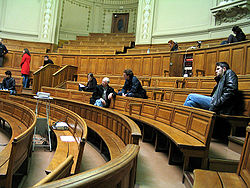
Back صالة محاضرات Arabic Аўдыторыя BE-X-OLD Аудитория Bulgarian Auditorium Czech Auditorium Danish Hörsaal German Aŭditorio Esperanto Anfiteatro (aula) Spanish Amphithéâtre (éducation) French Anfiteatro (aula) Galician



A lecture hall or lecture theatre is a large room used for lectures, typically at a college or university. Unlike flexible lecture rooms and classrooms with capacities normally below one hundred,[1][2] the capacity of lecture halls can sometimes be measured in the hundreds. Lecture halls frequently have tiered seating, with those in the rear sat higher than those at the front.
Lecture halls differ from other types of learning spaces, seminar rooms in particular, in that they allow for little versatility in use,[3] although they are no less flexible than, for example, chemistry laboratories. Experimentation, group work, and other contemporary educational methods are not practicable in a lecture hall. On the other hand, lecture halls are excellent for focusing the attention of a large group on a single point, either an instructor or an audio-visual presentation, and modern lecture halls often feature audio-visual equipment. A microphone and loudspeakers are common to help the lecturer be heard, and projection screens may be used for large displays.
Studies into the use of the lecture theatre teaching space have found that students sit in specific locations due to a range of factors; these include being noticed, addressing anxiety or an ability to focus. Personal and social factors are also thought to determine students' lecture theatre seating choice and the resulting effects on attainment. Studies into the way students use the space indicate that peer group formation exerts a strong impact on attainment and engagement, with groups of similar ability sitting together.[4]
- ^ "Inside the TLC". 22nd Biennial New Chaucer Society Congress, Durham 2022. Archived from the original on 25 March 2023. Retrieved 23 February 2023.
- ^ Cite error: The named reference
UCLwas invoked but never defined (see the help page). - ^ "Large Lecture Hall Design". Center for Research on Learning and Teaching. Archived from the original on 2010-08-19. Retrieved 2011-01-23.
- ^ Smith, David P.; Hoare, Angela; Lacey, Melissa M. (2018-08-21). "Who goes where? The importance of peer groups on attainment and the student use of the lecture theatre teaching space". FEBS Open Bio. 8 (9): 1368–1378. doi:10.1002/2211-5463.12494. ISSN 2211-5463. PMC 6120247. PMID 30186739.
 Material was copied from this source, which is available under a Creative Commons Attribution 4.0 International License.
Material was copied from this source, which is available under a Creative Commons Attribution 4.0 International License.
© MMXXIII Rich X Search. We shall prevail. All rights reserved. Rich X Search